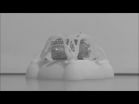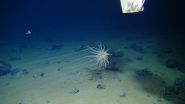(Press-News.org) Traditional industrial robots are rigid -- mostly metal -- and are fast, precise and powerful. Their speed and precision comes at the cost of complexity and can often pose a danger to humans who get too close. Soft robots are adaptable and resilient but slow, difficult to fabricate, and challenging to make autonomous because most motors, pumps, batteries, sensors, and microcontrollers are rigid.
But what if you could combine the autonomy and speed of a rigid robot with the adaptability and resiliency of a soft robot -- and do it relatively cheap and fast?
Harvard engineers have done just that, developing one of the first 3-D printed, soft robots that moves autonomously. Described in the July 10, 2015 issue of the journal Science, the design offers a new solution to an engineering challenge that has plagued soft robotics: the integration of rigid and soft materials.
The robot's body transitions from soft to hard, reducing the stress where the rigid electronic components join the body and increasing the robot's resiliency. The body's monolithic design -- created in one continuous print job, using several different materials -- increases its strength and robustness. With no sliding parts or traditional joints, the robot isn't victim to dirt or debris like its more intricate cousins, making it a good candidate for use in harsh terrains.
"The vision for the field of soft robotics is to create robots that are entirely soft," said senior author Robert J. Wood, Charles River Professor of Engineering and Applied Sciences at the Harvard John A. Paulson School of Engineering and Applied Sciences (SEAS) and Core Faculty Member at the Wyss Institute for Biologically Inspired Engineering at Harvard. "But for practical reasons, our soft robots typically have some rigid components -- things like batteries and control electronics. This robot is a demonstration of a method to integrate the rigid components with the body of the soft robot through a gradient of material properties, eliminating an abrupt hard-to-soft transition that is often a failure point."
The combustion-powered robot -- reminiscent of a toy rubber popper -- is comprised of two main parts: a soft plunger-like body with three pneumatic legs and the rigid core module, containing power and control components and protected by a semi-soft 3-D printed shield. The design builds from previous work of co-author and chemist George Whitesides, the Woodford L. and Ann A. Flowers University Professor.
To initiate movement, the robot inflates its pneumatic legs to tilt its body in the direction it wants to go. Then butane and oxygen are mixed and ignited, catapulting the robot into the air. It's a powerful jumper, reaching up to six times its body height in vertical leaps and half its body width in lateral jumps. In the field, the hopping motion could be an effective way to move quickly and easily around obstacles.
"The wonderful thing about soft robots is that they lend themselves nicely to abuse," said Nicholas Bartlett, first author of the paper and a graduate student at SEAS. "The robot's stiffness gradient allows it to withstand the impact of dozens of landings and to survive the combustion event required for jumping. Consequently, the robot not only shows improved overall robustness but can locomote much more quickly than traditional soft robots."
The robot's jumping ability and soft body would come in handy in harsh and unpredictable environments or disaster situations, allowing it to survive large falls and other unexpected situations.
This new design demonstrates the possibilities of 3-D printing in soft robotics. Traditional methods of fabrication -- custom molds and multi-step assembly -- are costly and slow. The ever-increasing variety of materials compatible with 3-D printers is allowing engineers to prototype new designs faster, and increased complexity does not necessarily lead to increased cost.
"Soft robotics is a relativity nascent subfield and 3-D printing is adding to the repertoire of things we can do in a really practical way," said Wood.
INFORMATION:
The co-first author of the paper is Michael Tolley, of University of California, San Diego. Coauthors include Johannes T.B. Overvelde and Katia Bertoldi of SEAS; James Weaver of the Wyss Institute; Bobak Mosadegh of Weill Cornell Medical College; and George Whitesides of Harvard and the Wyss Institute.
This research was supported by the National Science Foundation and Wyss Institute at Harvard University. Harvard's Office of Technology Development has filed for a provisional patent on the technology and is actively pursuing commercialization opportunities.
The Harvard John A. Paulson School of Engineering and Applied Sciences (SEAS) serves as the connector and integrator of Harvard's teaching and research efforts in engineering, applied sciences, and technology. Through collaboration with researchers from all parts of Harvard, other universities, and corporate and foundational partners, we bring discovery and innovation directly to bear on improving human life and society. For more information, visit http://seas.harvard.edu.
Monterey, CA - Thousands of feet below the ocean's surface lies a hidden world of undiscovered species and unique seabed habitats--as well as a vast untapped store of natural resources including valuable metals and rare-earth minerals. Technology and infrastructure development worldwide is dramatically increasing demand for these resources, which are key components in everything from cars and modern buildings to computers and smartphones. This demand has catalyzed interest in mining huge areas of the deep-sea floor.
In a paper published this week in Science, researchers ...
Engineers at Harvard University and the University of California, San Diego, have created the first robot with a 3D-printed body that transitions from a rigid core to a soft exterior. The robot is capable of more than 30 untethered jumps and is powered by a mix of butane and oxygen. Researchers describe the robot's design, manufacturing and testing in the July 10 issue of Science magazine.
"We believe that bringing together soft and rigid materials will help create a new generation of fast, agile robots that are more robust and adaptable than their predecessors and can ...
New York, 9 July - Investing up to 3.5% of a nation's GDP in science, technology and innovation - including basic science and education - is a key benchmark for advancing sustainable development effectively, leading experts say.
In papers released July 9 in New York, international scientists advising UN Secretary-General Ban Ki-moon say closing the gap between developed and developing countries depends on first closing international science, technology and innovation (STI) investment gaps.
According to the UN SG's 26-member Scientific Advisory Board: "While a target ...
Black holes can be found at the centres of most galaxies. Most have little mass compared with their host galaxy. ETH researchers, however, have discovered a particularly massive black hole, which clearly grew so quickly that the host galaxy was not able to keep pace. This calls into question previous thinking on the co-evolution of galaxies and their central black holes.
Benny Trakhtenbrot, a researcher at ETH Zurich's Institute for Astronomy, together with an international team of astrophysicists, was hunting for ancient massive black holes using the 10 meter Keck telescope ...
Many areas of fundamental research are interested in graphene owing to its exceptional characteristics. It is made of one layer of carbon atoms, which makes it light and sturdy, and it is an excellent thermal and electrical conductor. Despite its apparently limitless potential, however, few applications have been demonstrated to date. Scientists at EPFL's Bionanophotonic Systems Laboratory (BIOS) together with researchers from the Institute of Photonic Sciences (ICFO, Spain) have now added another one. They have harnessed graphene's unique optical and electronic properties ...
CORVALLIS, Ore. - A new review analyzing three decades of research on the historic effects of melting polar ice sheets found that global sea levels have risen at least six meters, or about 20 feet, above present levels on multiple occasions over the past three million years.
What is most concerning, scientists say, is that amount of melting was caused by an increase of only 1-2 degrees (Celsius) in global mean temperatures.
Results of the study are being published this week in the journal Science.
"Studies have shown that both the Greenland and Antarctic ice sheets ...
Scientists at the University of East Anglia, University of Barcelona, University Pompeu Fabra and several other European institutions have found a way to separate the medical benefits of cannabis from some of its unwanted side effects.
The research comes from the team that had previously discovered how the main psychoactive ingredient in cannabis, known as tetrahydrocannabinol or THC, reduces tumour growth in cancer patients.
Their latest findings, publishing on July 9th in the Open Access journal PLOS Biology, reveal how some detrimental cognitive effects of THC are ...
Many animals actively touch objects in their environment and respond to them by appropriate movement sequences. Jan Ache and Volker Dürr from Bielefeld University in Germany present a model in PLOS Computational Biology that captures key properties of a wide variety of descending neurons that are part of an "active touch system".
Goal-directed actions require neurons that descend from the brain to lower parts of the nervous system, for example: to distribute sensory information to local modules of movement control. Stick insects actively explore the near-range environment ...
In a genome-sequencing study of pancreatic cancers and blood in 101 patients, Johns Hopkins Kimmel Cancer Center scientists say they found at least one-third of the patients' tumors have genetic mutations that may someday help guide precision therapy of their disease. Results of blood tests to detect DNA shed from tumors, they say, also predicted cancer recurrence more than half a year earlier than standard imaging methods.
"Pancreatic cancer has one of the highest death rates among cancer types. Many people think there are no treatment options, but our study shows that ...
Washington, DC--People who have diabetes and experience high rates of complications are more likely to develop dementia as they age than people who have fewer diabetic complications, according to a new study published in the Endocrine Society's Journal of Clinical Endocrinology & Metabolism.
An individual develops diabetes when the pancreas doesn't produce enough of the hormone insulin or the body can't use insulin properly to process sugar. When blood sugar levels remain high due to uncontrolled diabetes, serious complications can develop, including blindness, kidney ...





